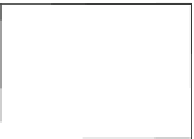Biomedical Engineering Reference
In-Depth Information
Fig. 3.4
Representation of
a practical method to
determine the center of
gravity of a sheet of paper.
Its initial and final positions
are shown
1
axis of rotation
initial situation
1
final situation
This method, illustrated in Fig.
3.4
, will be applied to a flat body, such as a sheet
of paper. Let us consider a rectangular and homogeneous sheet of paper. At the
beginning, we choose an axis of rotation perpendicular to this sheet and fix it to a
wall with a thumbtack, with the possibility to rotate. When the sheet is loosened, it
will rotate and the final equilibrium situation is reached. Then, two questions arise:
(a) Why does sheet rotate when it is released?
(b) Why does sheet stop rotating and remain in a certain position at the final
equilibrium situation?
To answer such questions, we have to consider the torque of the weight force
about an axis of rotation defined at the point where it is fixed. Certainly, we can
consider that the center of gravity of the sheet is not at the axis of rotation, but at
some distance from it, as shown in Fig.
3.5
. Being so, there will be the lever arm of
the weight, whose torque will rotate the sheet. This is the answer to the first
question.
To explain why the sheet stops rotating and reaches the final situation, we should
remember that if there is no rotation, there is no torque, or better, the torque
becomes zero. Knowing that the torque is given by the product of weight by the
lever arm
d
⊥
, and the weight did not change, we conclude that
d
⊥
became zero. This
happens when the line of action of the weight force and therefore the C.G. of the
body is on the vertical line which passes through the axis of rotation as can be seen
in Fig.
3.5
. This is the answer to the second question.
We have drawn a dotted vertical straight line at the final situation passing along
the axis of rotation in Fig.
3.4
. The C.G. must be found on this line. The precise








